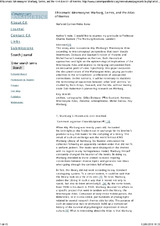Mostrar el registro sencillo del ítem
Rhizomatic Mnemosyne: Warburg, Serres, and the Atlas of Hermes
| dc.contributor.author | Molina Barea, María del Carmen | |
| dc.date.accessioned | 2018-01-12T13:39:19Z | |
| dc.date.available | 2018-01-12T13:39:19Z | |
| dc.date.issued | 2018 | |
| dc.identifier.uri | http://hdl.handle.net/10396/15827 | |
| dc.description.abstract | This essay aims to examine Aby Warburg’s Mnemosyne Atlas according to two conceptual perspectives that seem deeply interwoven, Deleuze and Guattari’s notion of rhizome and Michel Serres’s metaphor on Hermes. Both theoretical approaches cast light on the epistemological implications of the Mnemosyne Atlas and explore its intriguing composition from an innovative point of view. Specifically, this paper excavates the disrupted nature of the Warburgian Atlas, paying particular attention to the schizophrenic proliferation of unexpected connections. In this scenario, it will be necessary to elucidate the terminological opposition between ‘atlas’ and ‘archive,’ as studied by Boris Groys, Foucault, and Derrida, without leaving aside Didi-Huberman’s pioneering research on Warburg | es_ES |
| dc.format.mimetype | application/pdf | es_ES |
| dc.language.iso | eng | es_ES |
| dc.publisher | RISD | es_ES |
| dc.rights | https://creativecommons.org/licenses/by-nc-nd/4.0/ | es_ES |
| dc.source | Contemporary Aesthetics 1 (2018) | es_ES |
| dc.subject | Archive | es_ES |
| dc.subject | Cartography | es_ES |
| dc.subject | Gilles Deleuze | es_ES |
| dc.subject | Félix Guattari | es_ES |
| dc.subject | Hermes | es_ES |
| dc.subject | Mnemosyne Atlas | es_ES |
| dc.subject | Rhizome | es_ES |
| dc.subject | Schizophrenia | es_ES |
| dc.subject | Michel Serres | es_ES |
| dc.subject | Aby Warburg | es_ES |
| dc.title | Rhizomatic Mnemosyne: Warburg, Serres, and the Atlas of Hermes | es_ES |
| dc.type | info:eu-repo/semantics/article | es_ES |
| dc.relation.publisherversion | http://www.contempaesthetics.org/newvolume/pages/article.php?articleID=812 | es_ES |
| dc.rights.accessRights | info:eu-repo/semantics/openAccess | es_ES |

